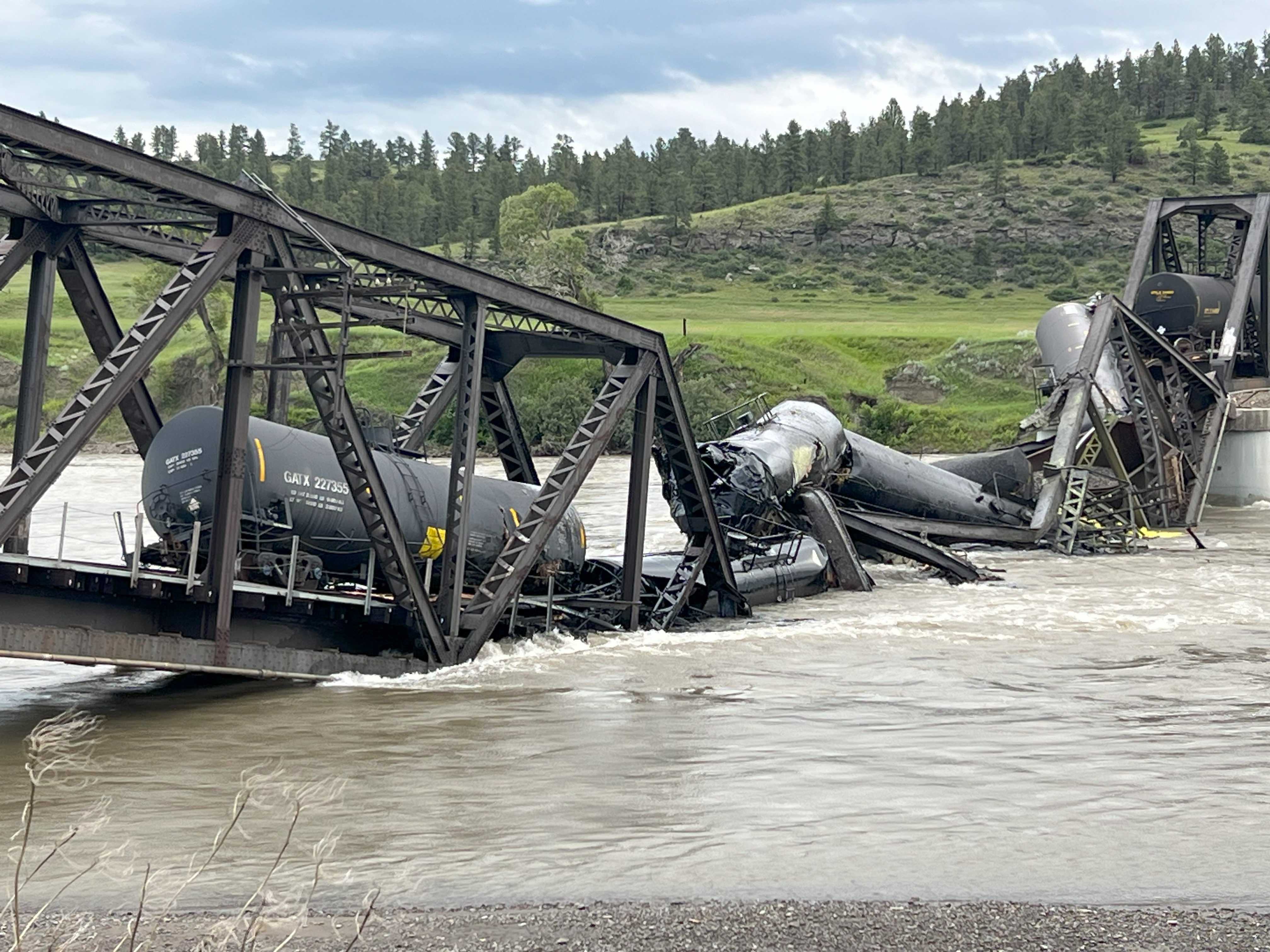Response Bureau

Stillwater County Train Derailment - Photo courtesy of Stillwater County DES
Response Programs
The State Emergency Coordination Center is managed with a NIMS/ICS model that incorporates Operations, Planning, Finance/Admin, and Logistic Sections. As an incident grows in scale or complexity, the SECC organizational structure may grow as additional functions are activated, such as a Public Works Group under Operations. In addition to five full time staff, the SECC team can be augmented by District Field Officers, other Division staff and local DES Coordinators as needed.
Contacts:
| SECC Coordinator, Tam Kolar | Tkolar@mt.gov | (406) 417-9240 |
| SECC Coordinator, Michael Mooney | michael.mooney@mt.gov | (406) 417-9351 |
| SECC Coordinator, Justin Webster | Justin.Webster@mt.gov | (406) 417-9352 |
| Warehouse Coordinator, Doug Raymer | douglas.raymer@mt.gov | (406) 202-3437 |
District Field Officers, or “DFOs,” are emergency management specialists serving as the agency’s liaisons to local jurisdictions. They are knowledgeable about all phases of emergency management: preparedness, prevention, mitigation, response, and recovery, and they come from a variety of backgrounds and experiences.
Emergency Management Assistance Compact
EMAC is the nation’s all hazard national mutual aid system ratified by U.S. Congress (PL 104-321) and is law in all 50 states, the District of Columbia, Puerto Rico, Guam, the U.S. Virgin Islands and the Northern Mariana Islands. EMAC is codified in Montana Coded Annotated 10-3-1001, 10-3-1002, and 10-3-1003. Through EMAC, states can share resources from all disciplines, protect personnel who deploy, and be reimbursed for mission related costs. The nation’s most efficient, scalable and flexible mutual aid system is implemented in Montana by Disaster and Emergency Services on behalf of the Governor. This provides a consistent and coordinated response across the nation. EMAC offers assistance during governor-declared states of emergency or disaster through a responsive, straightforward system that allows states to send personnel, equipment, and commodities to assist with response and recovery efforts in other states.
The strength of EMAC and the quality that distinguishes it from other plans and compacts lie in its governance structure; its relationship with federal agencies, national organizations, states, counties, territories, and regions; the willingness of state and response and recovery personnel to deploy; and the ability to move any resource one state wishes to utilize to assist another state.
Intrastate Mutual Aid System
In Montana, emergencies and disasters are managed at the lowest jurisdictional level possible. And yet, few jurisdictions have all of the resources they need to manage larger scale emergencies and disasters. To help support these jurisdictions when they get overwhelmed, Montana has codified the Intrastate Mutual Aid System (MT IMAS). The IMAS allows political subdivisions to maintain maximum flexibility to protect life and property through previously developed local mutual aid agreements or, in the absence of local agreements, under the IMAS code (MCA 10-3-9).
IMAS also gives the Division of Montana Disaster & Emergency Services responsibility for establishing all-hazard incident management assistance teams and for appointing the members of the Montana Intrastate Mutual Aid Committee or “IMAC”.
The IMAC is responsible for:
- reviewing the progress and status of intrastate mutual aid;
- assisting in developing methods to track and evaluate activation of the system;
- examining issues facing member jurisdictions in the implementation of intrastate mutual aid;
- developing, adopting, and disseminating comprehensive guidelines and procedures that address the following:
- projected or anticipated costs of establishing and maintaining the system;
- checklists for requesting and providing intrastate mutual aid assistance;
- recordkeeping for all member jurisdictions; and
- procedures for reimbursing the actual and legitimate expenses of a member jurisdiction that responds to a request for aid or assistance through the system; and
- adopting any other guidelines or procedures considered necessary by the committee to implement an effective and efficient system.
The State Emergency Response Commission (SERC) members are appointed by the governor. The eight-member commission advises the Governor on emergency response and preparedness issues relevant to administering state and federal requirements. The SERC may select members, or other subject matter experts to serve on committees and subcommittees set up by the commission. To learn more, click here.
Montana State Hazardous Materials Incident Response Teams
Local Assets – State Resources
The State of Montana has six (6) Regional Hazardous Materials teams.
The teams are made up of local fire department resources located in the following cities:
• Billings
• Bozeman
• Helena
• Great Falls,
• Kalispell
• Missoula
When needed, these local resources can be mobilized as State Teams to assist any State, Tribal, or local agency or jurisdiction needing hazmat technical assistance.
The teams work under the authority of the local Incident Commander, and Incident Command System (ICS) organization. They do not “take over” at local incidents.
Expertise and Equipment
All teams are staffed with National Fire Protection Association (NFPA) Certified Hazardous Material Technicians who are available by phone 24/7, 365 days a year.
Additionally, they have an arsenal of specialized equipment including vehicles, trailers, testing equipment, personal protection equipment (PPE), and drones.
How to Request Assistance
HazMat Teams can be requested as a local resource; however, there is a process, and information will be needed when requesting assistance. For detailed information, download the complete Montana State Hazardous Materials Incident Response Teams brochure here.
To request HazMat Team assistance, contact the Montana DES Duty Officer at 406-431-0411.
Montana Disaster and Emergency Services is proud to support the Montana National Guard’s relationship-building initiative under the State Partnership Program (SPP). MT DES staff and leadership have provided emergency response subject matter expertise to our partner countries both in Montana and abroad. Click here to learn more.
There is an account in the state special revenue fund established in 17-2-102. The account must be administered by the Disaster and Emergency Services Division of the Department of Military Affairs exclusively for the purposes of search and rescue as provided in this section.
The funds are used by Disaster and Emergency Services to defray the costs of local search and rescue units for search and rescue missions conducted through a county sheriff's office at a maximum of $12,000 for each rescue mission, regardless of the number of counties or county search and rescue organizations involved. The remaining money in the account may be used by Disaster and Emergency Services Division for reimbursement of expenses related to the training of search and rescue volunteers, and to match local funds for the purchase of equipment for use by local search and rescue units at a maximum of $12,000 for each unit in a calendar year. The cost-sharing match must be 35% local funds to 65% from the account.”
As of July 1, 2023, all reimbursement requests must be submitted via the online form.
For questions on reimbursement requests or submission forms, please contact:
Nanette Gilbertson
MT Sheriffs and Peace Officers Assn.
nanette@smithandmcgowan.com
O: 406-443-1570
C: 406-459-9892
Search and Rescue Reimbursement Submission Forms & Resources
Mission Reimbursement - Online Submission Form
Equipment Reimbursement - Online Submission Form
The Emergency Alert System (EAS) is a national public warning system that requires broadcasters, cable television systems, wireless cable systems, satellite digital audio radio service (SDARS) providers, and direct broadcast satellite (DBS) providers to provide the communications capability to the President to address the American public during a national emergency. The system also may be used by state and local authorities to deliver important emergency information, such as AMBER alerts and weather information targeted to specific areas.
The FCC, in conjunction with Federal Emergency Management Agency (FEMA) and the National Oceanic and Atmospheric Administration's National Weather Service (NWS), implements the EAS at the federal level. The President has sole responsibility for determining when the EAS will be activated at the national level, and has delegated this authority to the director of FEMA. FEMA is responsible for implementation of the national-level activation of the EAS, tests, and exercises. The NWS develops emergency weather information to alert the public about imminent dangerous weather conditions.
The FCC's role includes prescribing rules that establish technical standards for the EAS, procedures for EAS participants to follow in the event The EAS is activated, and EAS testing protocols. Additionally, the FCC ensures that the EAS state and local plans developed by industry conform to FCC EAS rules and regulations.
The Montana DES Response Bureau is charged with coordinating operational response at the state level for any incident, emergency, or disaster that exceeds the capabilities of the local jurisdiction. Support for incidents can include deployment of resources, incident management assistance, technical assistance, and the deployment of Montana DES District Field Officers as Agency Representatives. Through mutual aid agreements, memorandums of understanding, and other protocols and authorities, aid can be requested from other states, federal partners, and other nations, as well as Voluntary Organizations Active in Disaster (VOADS). The primary document for guiding state response is the Montana Emergency Response Framework (MERF).
The Response Bureau maintains a 24-hour Duty Officer Program, which is the initial point of contact for jurisdictions seeking assistance or reporting an incident. Based on the size and complexity of an incident, the Response Bureau may elect to activate the State Emergency Coordination Center (SECC), which is located at Fort Harrison, Montana.
The SECC provides support to local and state level incidents by handling requests for assistance or resources as well as sharing situational awareness updates to our partners and stakeholders.
Other responsibilities of the Response Bureau include:
-
Maintaining day-to-day situational awareness of any incidents that may significantly affect the state such as severe weather or wildfires.
-
Coordination of National Guard assistance for any civil emergency or disaster.
-
Preparing draft executive orders for disasters and emergency for review by the Office of the Governor.
- Chairing the State Emergency Response Commission (SERC) and mobilization and deployment of the Regional Hazmat Teams.
- Oversight and coordination of All Hazard Incident Management Teams.
- Resource mobilization and disaster warehouse management.
- Coordination of EMAC requests from other States and U.S. Territories.

